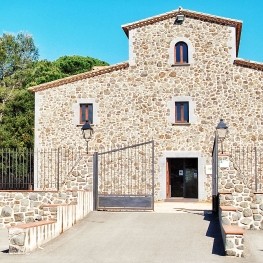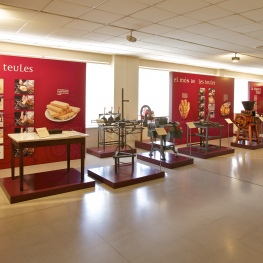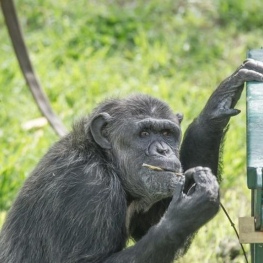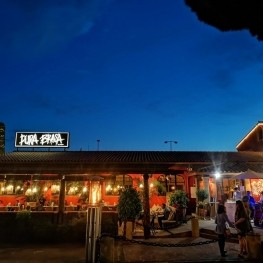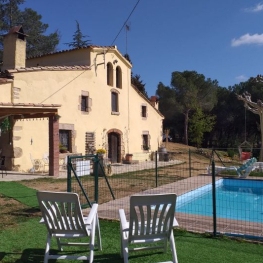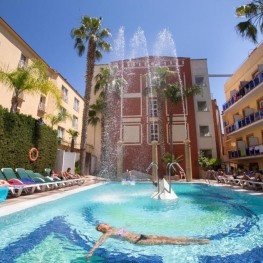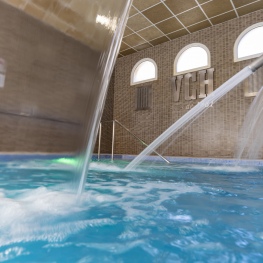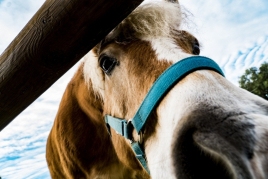The mystery of Camp dels Ninots
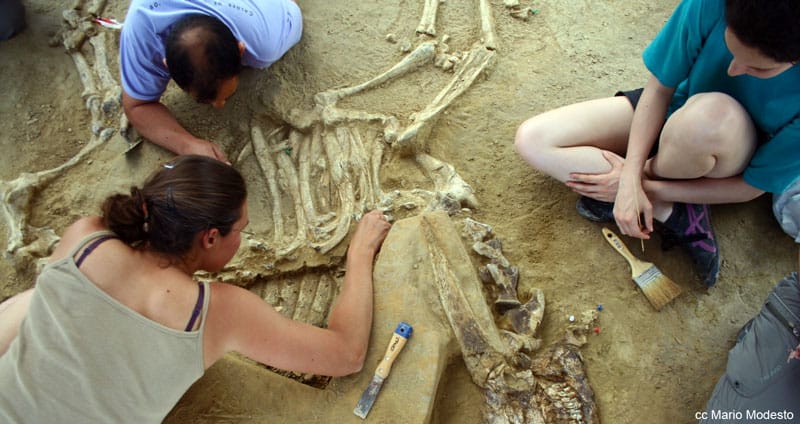
Despite being unknown to many tourist routes in the province of Girona, more focused on coastal areas, El Camp dels ninots (field of the dolls) is one of the most important archaeological sites in Catalonia, and in the Iberian Peninsula in In general, due to the impressive fossil remains discovered inside, which enjoy an extraordinary state of conservation.
The originality of its name comes from the capricious shapes adopted by the opal stones that abound in the area and are traditionally known as " ninots " (dolls).
volcanic lands
 Located on the Massanet-Caldes fault, in the La Selva region, this ancient crater measuring 650 x 1,000 meters in diameter was the protagonist of one of the eruptions that the province of Girona suffered during the Neogene and Quaternary periods (Cenozioca era). Geologically unstable area like few others, the volcanoes first erupted in the Empordà area, to continue in La Selva and end in La Garrotxa.
Located on the Massanet-Caldes fault, in the La Selva region, this ancient crater measuring 650 x 1,000 meters in diameter was the protagonist of one of the eruptions that the province of Girona suffered during the Neogene and Quaternary periods (Cenozioca era). Geologically unstable area like few others, the volcanoes first erupted in the Empordà area, to continue in La Selva and end in La Garrotxa.
After erupting more than five million years ago, the La Selva volcano belongs to the Pliocene age, a time that coincides with the opening of the Mediterranean Sea and the creation of the Strait of Gibraltar. In fact, various studies consider that the eruption was produced by the introduction of water into it, which connected with internal magma foci.
the region of water
 And it is that the volcano was an immense lake during long periods of its history, surely with islands in its interior. In addition, its special geological location has endowed it with notable singularities with respect to the other two faults, despite the fact that all three have experienced similar geological periods.
And it is that the volcano was an immense lake during long periods of its history, surely with islands in its interior. In addition, its special geological location has endowed it with notable singularities with respect to the other two faults, despite the fact that all three have experienced similar geological periods.
Being in the heart of the two main vertebrae of the Catalanides, it has been subjected to great geological forces that caused a subsidence in its southern part that can even be seen today along the Sta. Coloma - Riudarenas - Sils - Vidreras - axis. North Maçanet and Caldes de Malavella, an area that for millions of years was flooded by lakes and ponds.
the lake of sils
 Another of its characteristics is its isolation, responsible for the fact that a part still survives today in Lake Sils. According to what they say, this lake was bigger than Catalonia itself, although today it is hard to imagine. It is not for nothing that he is related to Egypt when pointing out that just as important as the Nile is for this country, the lake is for Sils.
Another of its characteristics is its isolation, responsible for the fact that a part still survives today in Lake Sils. According to what they say, this lake was bigger than Catalonia itself, although today it is hard to imagine. It is not for nothing that he is related to Egypt when pointing out that just as important as the Nile is for this country, the lake is for Sils.
This particularity leads to another specific characteristic, having been subject to periodic invading phases of marine waters through the Empordà trench. As we have said, despite the fact that La Selva was isolated, both to the north and to the south, the waters that filled the great pit of Empordà overflowed and reached there, creating sectors of marine waters.
The enormous pit gave rise to a large number of volcanoes, including Sant Corneli, Crosa de Sant Dalmai, Hostalric Castle and, above all, Camp dels ninots.
planet discoveries
 Although the first geological works date back to the year 1882, by the hand of Doctor Lluís M. Vidal, it has been thanks to the investigations of the Archaeological Association of Girona, continued later by the Rovira i Virgili University of Tarragona and the Catalan Institute of Paleoecology. Humana i Evolució Social ( IPHES ), which have found fossil remains of plants, large and small mammals, as well as other aquatic animals and insects.
Although the first geological works date back to the year 1882, by the hand of Doctor Lluís M. Vidal, it has been thanks to the investigations of the Archaeological Association of Girona, continued later by the Rovira i Virgili University of Tarragona and the Catalan Institute of Paleoecology. Humana i Evolució Social ( IPHES ), which have found fossil remains of plants, large and small mammals, as well as other aquatic animals and insects.
This has left researchers with their mouths open, even more so if we take into account that such a quantity of remains from the Lower Pleistocene had never been found in the same area and in an exceptional state of conservation. As if this were not enough, remains of hominid tools have also been located that corroborate settlements of our ancestors at that time.
These discoveries have provided information about the climate on the European continent (much more temperate, 5ºC lower, and humid than today), the environment and the fauna existing in the moments before the appearance of Homo. And it is that the contribution of information from the Camp dels ninots regarding the changes that the planet suffered in the interglacial era (and that changed the course of human evolution) is incalculable.
Why have all the animals appeared whole?
 It cannot be denied that the conditions of the Camp dels ninots lake were optimal for both animal and plant life. The characteristics of its waters, with a very strong mineralization due to the presence of the volcano, allowed an excellent conservation of any body that fell into its extensive lagoon.
It cannot be denied that the conditions of the Camp dels ninots lake were optimal for both animal and plant life. The characteristics of its waters, with a very strong mineralization due to the presence of the volcano, allowed an excellent conservation of any body that fell into its extensive lagoon.
Thanks to this aquatic quality, complete skeletons of a rhinoceros, three bovids (of a species currently extinct and very little known on the continent) and a tapir (the most complete known in Europe) have appeared. In addition to other smaller animals, such as rodents, hedgehogs, birds, turtles, amphibians, reptiles, and insects.
However, what is most striking is the fact that all the skeletons have appeared whole and in the same chronological period. From which it can be deduced that an extraordinary phenomenon occurred, such as a natural catastrophe, which killed them suddenly, perhaps due to the gaseous emanations from the volcano.
historical baths
 Although at present the fault does not pose any danger (at least in the long term, since the volcanoes never stop being active), the crater gives the waters of the area a thermal functionality that characterizes them by their temperature and chemical composition that comes from inside the earth. As demonstrated by the number of spas that have proliferated in the area in recent years.
Although at present the fault does not pose any danger (at least in the long term, since the volcanoes never stop being active), the crater gives the waters of the area a thermal functionality that characterizes them by their temperature and chemical composition that comes from inside the earth. As demonstrated by the number of spas that have proliferated in the area in recent years.
In fact, it is worth noting the Roman Baths of Sant Grau, a monument of national interest that remains in such a good state of conservation that even the water mechanisms of its baths still work.
Caldes de Malavella
 And it is that the history of this municipality is closely linked to the hot springs that run through the subsoil. Located on an ancient thermal enclave from the Roman Empire, its remains can still be seen in the streets of the center of Caldes de Malavella. In fact, its name comes from the Roman " Aquae Calidae " ( Warm Waters ), to which " Malavella " (malavieja) was added in reference to a woman, who seems to be very ugly and old, who lived in the castle of San Mauricio.
And it is that the history of this municipality is closely linked to the hot springs that run through the subsoil. Located on an ancient thermal enclave from the Roman Empire, its remains can still be seen in the streets of the center of Caldes de Malavella. In fact, its name comes from the Roman " Aquae Calidae " ( Warm Waters ), to which " Malavella " (malavieja) was added in reference to a woman, who seems to be very ugly and old, who lived in the castle of San Mauricio.
However, it would not be until 1840 when the first modern building for the thermal baths was built, under the name of " Els Bullidors ", in what would be the precedent of the current spas of the 20th century with modernist architecture.
The development of this municipality was thus inevitably linked to water, in the same way that all the economic activities carried out in the area would go little by little towards the hot springs until they began to sell mineral water, in what will be a new service in the thirties. This incipient sale of water will promote the industry of the place in the following years.
What to do
Museu de la Pagesia de Fogars de la Selva
Fogars de la Selva (a 11.2 Km)The Museum of the Peasant of Fogars de la Selva wants us…
Museu Trias de la Galeta
Santa Coloma de Farners (a 7.9 Km)The Trias de la Galeta museum is the fruit of the Trias…
Fundació Mona
Riudellots de la Selva (a 6.6 Km)The Mona Foundation is a non-profit entity created to put an end…
Where to eat
L'Espai Gastronomia
Tossa de Mar (a 16.7 Km)Enjoy a place where laughter, festivity, and gastronomy unfold around a large…
Pura Brasa
Pineda de Mar (a 20.1 Km)A unique gastronomic experience: Pura Brasa is a friendly and fun concept…
Where to sleep
L'Azure Hotel
Lloret de Mar (a 14.4 Km)L'Azure is a new hotel designed for couples and families who want…
Can Baldiri
Santa Coloma de Farners (a 12.3 Km)Currently Can Baldiri is a home for tourist use by groups of…
Hotel Cleopatra Spa
Lloret de Mar (a 14.6 Km)The Hotel Cleopatra Spa is a 4 star hotel, inspired by the…
1881 Hotel Balneari Vichy Catalan
Caldes de MalavellaThe bicarbonated and sodium thermal waters of the Vichy Catalán Spring emerge…



